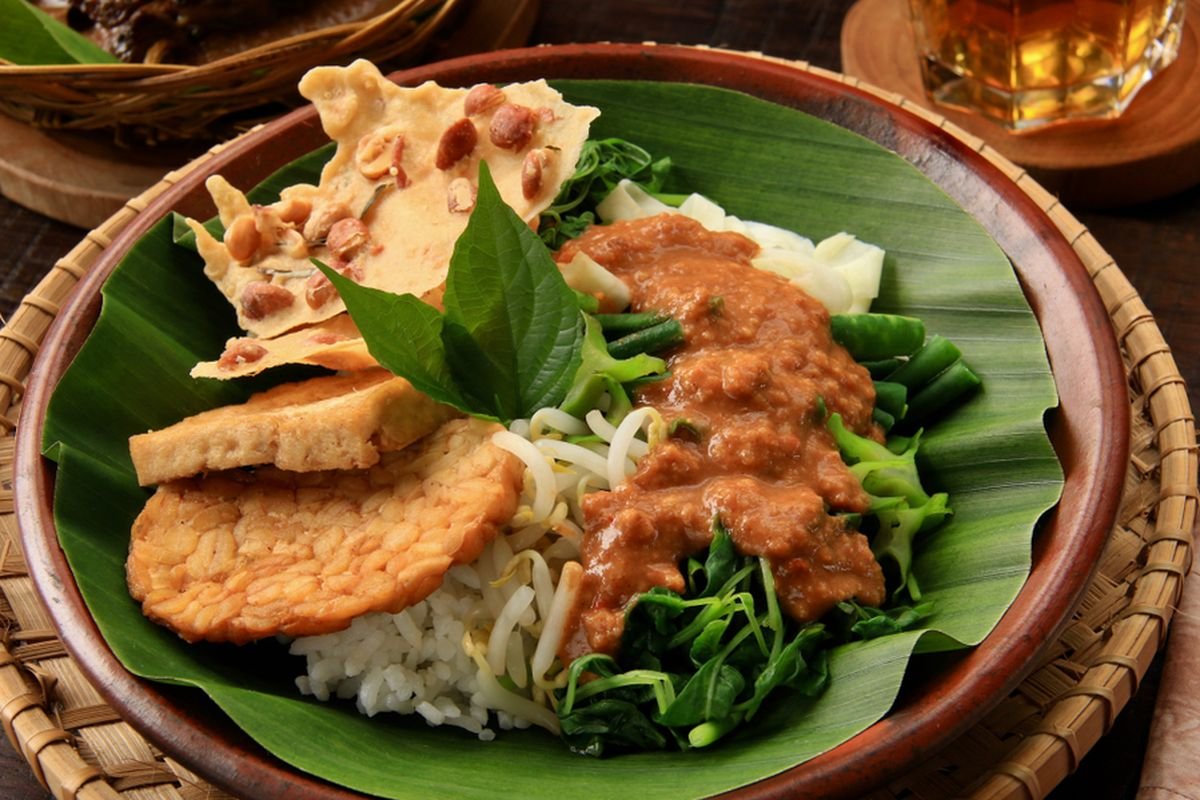How to Make Nasi Pecel – Classic Javanese Peanut Sauce Rice Bowl
Nasi Pecel is a vibrant and wholesome Indonesian dish that originates from Java. It features steamed white rice topped with a colourful array of boiled or blanched vegetables, generously drizzled with a rich peanut sauce (the “pecel” sauce). The result is a harmonious blend of textures and flavours—warm, comforting rice; crisp, lightly cooked greens; and a creamy, nut-forward, slightly sweet-spicy sauce. This dish is beloved for its balance of nutritious vegetables, plant-based protein and the earthy richness of peanut sauce. It works brilliantly as a satisfying lunch or dinner, and can be styled for vegetarian menus as well.
Ingredients
Below is a typical set of ingredients you’ll find in Nasi Pecel:
For the rice base:
- Steamed white rice (or you could substitute with brown / red rice for a healthier option)
- Optional: a banana leaf or plate liner for presentation
For the vegetables (select your mix):
- Kangkung (water spinach) or spinach
- Long beans (cut into portions)
- Bean sprouts (tauge)
- Cabbage (lightly shredded)
- Cassava leaves / papaya leaves / kenikir leaves (depending on region)
- Optional fresh basil leaves (kemangi)
For the peanut sauce (pecel sauce):
- Peanuts (roasted)
- Red chillies (or rawit for spiciness)
- Garlic
- Kencur (a small aromatic rhizome, optional)
- Tamarind (or asam jawa)
- Palm sugar (or brown sugar)
- Salt
- Water (or a little coconut milk for creaminess)
- Lime juice (optional, for a bit of freshness)
Optional accompaniments / toppings / protein add-ons:
- Tempeh or tofu (fried or lightly pan-seared)
- Rempeyek (crispy peanut cracker) or kerupuk
- Boiled or sliced egg
- Fried shallots on top
- Fresh cucumber slices or diced as garnish
Nutritional Composition (per serving)
Here is a rough estimate of the nutritional profile for one standard plate of Nasi Pecel (with vegetables + peanut sauce, excluding large fried protein add-ons).
- Calories: ~ 300–400 kcal depending on portion size and sauce quantity. Ambisius Wiki+1
- Carbohydrates: ~ 50–70 g (from rice plus vegetables) Ambisius Wiki
- Protein: ~ 10–15 g (from peanuts + tempeh/tofu if included) Ambisius Wiki+1
- Fat: ~ 5-10 g (peanut sauce contributes most) Ambisius Wiki+1
- Fibre: from the mix of vegetables, typically 4-8 g
- Vitamins & minerals: Depending on the vegetables used, you’ll get good amounts of Vitamin A, Vitamin C, Iron, Calcium, etc. Ambisius Wiki+1
- A note of caution: the peanut sauce can be rich in calories and fat (due to peanuts + sugar) and if lots of fried protein or large rice portions are used the total caloric load may rise significantly (upwards of 650–900 kcal) depending on additions
Serving Method
- Prepare the rice: Steam or cook the white rice until fluffy. Optionally, present it on a banana leaf for visual and flavour appeal.
- Cook the vegetables: Blanch or lightly boil each vegetable variety (kangkung, long beans, bean sprouts, cabbage leaves) just until tender-crisp, then drain well. Arrange them neatly on or beside the rice.
- Make the peanut sauce: Roast or fry peanuts and then grind or blend them with garlic, chillies, kencur (if using), tamarind (as-needed), palm sugar, salt and water (or a little coconut milk) until a smooth but thick sauce forms. Adjust seasoning to taste (sweet, salty, spicy, slightly tangy).
- Assemble: Place the rice on the plate, arrange the vegetables on top or beside it, then generously pour the peanut sauce over the vegetables and partly onto the rice (so the sauce mixes in as you eat).
- Add toppings: Add any extras like tempeh or tofu, boiled egg slices, rempeyek / crackers, fresh cucumber or basil leaves.
- Serve immediately: The dish is best enjoyed while the rice is warm and the vegetables still slightly crisp. Optionally, provide extra sauce on the side so diners can adjust spiciness/saucing.







